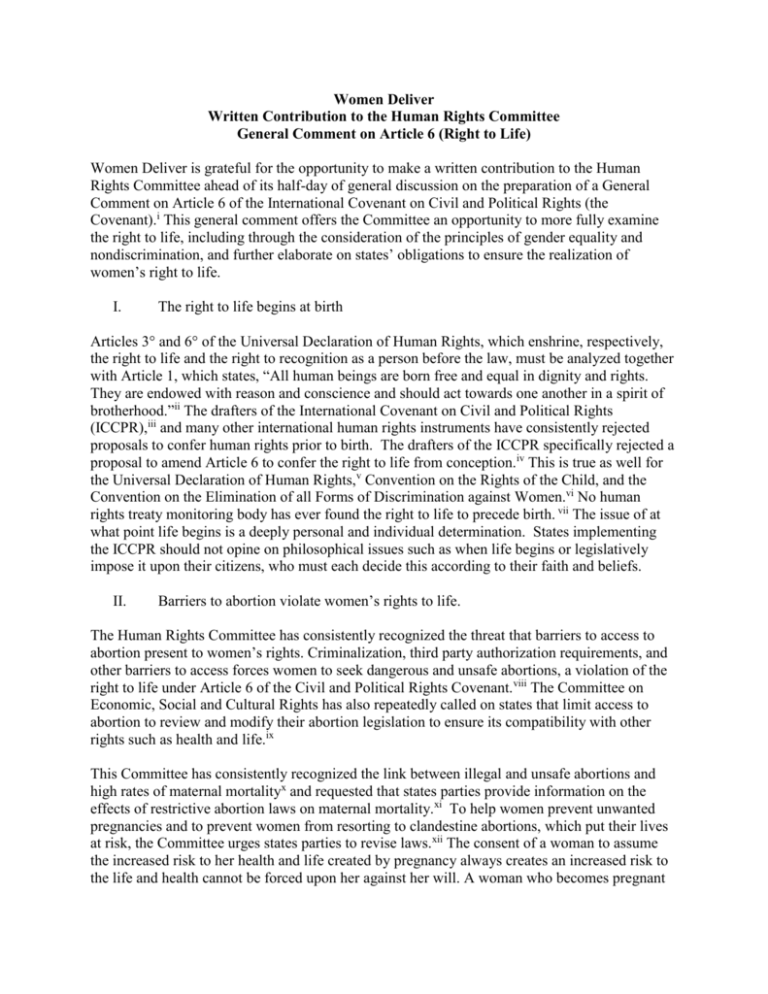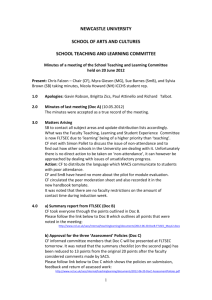Women Deliver - Office of the High Commissioner on Human Rights
advertisement

Women Deliver Written Contribution to the Human Rights Committee General Comment on Article 6 (Right to Life) Women Deliver is grateful for the opportunity to make a written contribution to the Human Rights Committee ahead of its half-day of general discussion on the preparation of a General Comment on Article 6 of the International Covenant on Civil and Political Rights (the Covenant).i This general comment offers the Committee an opportunity to more fully examine the right to life, including through the consideration of the principles of gender equality and nondiscrimination, and further elaborate on states’ obligations to ensure the realization of women’s right to life. I. The right to life begins at birth Articles 3° and 6° of the Universal Declaration of Human Rights, which enshrine, respectively, the right to life and the right to recognition as a person before the law, must be analyzed together with Article 1, which states, “All human beings are born free and equal in dignity and rights. They are endowed with reason and conscience and should act towards one another in a spirit of brotherhood.”ii The drafters of the International Covenant on Civil and Political Rights (ICCPR),iii and many other international human rights instruments have consistently rejected proposals to confer human rights prior to birth. The drafters of the ICCPR specifically rejected a proposal to amend Article 6 to confer the right to life from conception.iv This is true as well for the Universal Declaration of Human Rights,v Convention on the Rights of the Child, and the Convention on the Elimination of all Forms of Discrimination against Women.vi No human rights treaty monitoring body has ever found the right to life to precede birth. vii The issue of at what point life begins is a deeply personal and individual determination. States implementing the ICCPR should not opine on philosophical issues such as when life begins or legislatively impose it upon their citizens, who must each decide this according to their faith and beliefs. II. Barriers to abortion violate women’s rights to life. The Human Rights Committee has consistently recognized the threat that barriers to access to abortion present to women’s rights. Criminalization, third party authorization requirements, and other barriers to access forces women to seek dangerous and unsafe abortions, a violation of the right to life under Article 6 of the Civil and Political Rights Covenant.viii The Committee on Economic, Social and Cultural Rights has also repeatedly called on states that limit access to abortion to review and modify their abortion legislation to ensure its compatibility with other rights such as health and life.ix This Committee has consistently recognized the link between illegal and unsafe abortions and high rates of maternal mortalityx and requested that states parties provide information on the effects of restrictive abortion laws on maternal mortality.xi To help women prevent unwanted pregnancies and to prevent women from resorting to clandestine abortions, which put their lives at risk, the Committee urges states parties to revise laws.xii The consent of a woman to assume the increased risk to her health and life created by pregnancy always creates an increased risk to the life and health cannot be forced upon her against her will. A woman who becomes pregnant cannot be legally required to adopt such heroic behavior as to bear the enormous weight on her shoulders as continuing the pregnancy implies, nor such indifference for her worth as a rightsholder as to passively endure that her body, against her will, be subordinated or be used as an instrument of procreation. The Committee states in General Comment 28 that denial of access to safe abortion to women who have become pregnant as a result of rape constitutes a breach of the Article 7 right to be free from torture, cruel, inhumane and degrading treatment, and calls upon states reporting on women’s enjoyment of article 6 on the right to life, to “give information on any measures taken by the State to help women prevent unwanted pregnancies, and to ensure that they do not have to undergo life-threatening clandestine abortions.”xiii The criminalization of abortion in all circumstances implies a complete dominance of one of the legal interests at stake, the continued development of the fetus, and the subsequent absolute sacrifice of all the fundamental rights of the pregnant woman. It devalues a full and consolidated human life, protected by the right to life, who possesses this right by virtue of being a person and subject of law for the benefits of the so-called "unborn life," which is not recognized as a person, and which may eventually come to have some legal status of protection and possession of rights, conditional upon birth. Any measure which protects and elevates the possibility of life against the clear existence of a human being, the woman, is a state intrusion of such magnitude into the free development of the personality and human dignity as to completely deprive these rights of meaning. An obligation of this magnitude is a violation of human rights and of the state duty to guarantee equal access to health for all people, without discrimination on the basis of gender. III. Barriers to safe abortion violate women’s right to equality and freedom from discrimination This Committee has explicitly linked abortion to women’s equality in exercising their right to privacy, asking countries to report on laws and public or private actions that interfere with women’s equal enjoyment of the right to privacy, and to take measures to eliminate such interference.xiv Through the consideration of cases of human rights violations, this Committee has further clarified that the Article 6 right to life may be violated when women are exposed to a risk of death from unsafe abortion as a result of restrictive abortion laws. In the case of K.L. v. Peru, the Committee established that the denial of a therapeutic abortion, where continued pregnancy posed a significant risk to the life and mental health of the pregnant woman, violated the woman’s right to be free from cruel, inhuman, or degrading treatment.xv The Committee reaffirmed this decision in the case of L.M.R. v. Argentina, where it found the denial of a legal abortion for a rape victim inflicted physical and mental suffering, and violated the woman’s right to be free from torture or cruel, inhuman, or degrading treatment and her right to privacy. xvi All people have the right to equal access to life, and dignity under the UDHRxvii and the ICCPR Article 6 as well as to the highest attainable standard of health under the UDHR and ICESCR. Guaranteeing this right to men, but conditioning this right for women on the basis of gender is a violation of the right to be free from discrimination on the basis of gender, to be treated equally under the law, and to the right to life and health. In no circumstance are men denied the protection of their right to life or health when they require a medical treatment which would violate the right to life, health, dignity, autonomy or liberty if denied, simply on the basis of their gender. Criminalizing abortion applies a different criteria without justification to treat men and women differently with respect to their medical needs, violating women’s right to health on an equal basis with men, and affects an even graver violation on the equality of women with less power and resources. The denial of access to safe abortion constitutes discrimination against women which violates their right to life, health, dignity, autonomy and liberty. The criminalization of a medical practice that only women require violates the right to equality and ignores the violation of human rights that forcing a woman to carry an unwanted pregnancy creates, especially for those who are young, low-income, and/or ethnic minorities. A rule that penalizes abortion enforces the stereotype that women’s value is defined by their reproductive ability, without considering that the woman may want to choose other things in life, or that her own life itself might be sacrificed for that of a proposed life imposed upon her. According to the World Health Assembly, complications from unsafe abortion result in approximately 47,000 preventable maternal deaths per year.xviii With better access to contraception and safe abortion, these deaths could be dramatically reduce. A particular concern and area of vulnerability are the rights of young people. Women Deliver recognizes the fundamental nature of the human right to life, the exercise of which is essential for the exercise of all other rights. There are over 1.8 billion young people (aged 10-24) in the world today, the largest generation ever.xix They deserve to live in a world free from violence and discrimination and have the right to the highest attainable standard of health. Failure to provide comprehensive sexual and reproductive health information and services - including access to safe abortion - is a violation of the right to health and the right to life, and this violation leads to thousands of preventable deaths every year. As a leading, global advocate for girls’ and women’s health, rights, and wellbeing, Women Deliver brings together diverse voices and interests to drive progress in maternal, sexual, and reproductive health and rights. We build capacity, share solutions, and forge partnerships, together creating coalitions, communication, and action that spark political commitment and investment in girls and women. ii Universal Declaration of Human Rights, G.A. Res. 217A (III), U.N. Doc. A/810 at 71 (1948). iii International Covenant on Civil and Political Rights, G.A. res. 2200A (XXI), 21 U.N. GAOR Supp. (No. 16) at 52, U.N. Doc. A/6316 (1966), 999 U.N.T.S. 171, entered into force Mar. 23, 1976 [hereinafter ICCPR]. iv U.N. GAOR Annex, 12th Session, Agenda Item 33, ¶¶ 96, 113, 119, U.N. Doc. A/C.3/L.654 v Universal Declaration of Human Rights, G.A. Res. 217A (III), U.N. Doc. A/810 at 71 (1948). vi http://www.reproductiverights.org/sites/crr.civicactions.net/files/documents/RTL_Updated_8.18.14.pdf vii http://www.reproductiverights.org/sites/crr.civicactions.net/files/documents/RTL_Updated_8.18.14.pdf viii See, e.g., Chile, ¶ 15, U.N. Doc. CCPR/C/79/Add.104 (1999); El Salvador, ¶ 14, U.N. Doc. CCPR/CO/78/SLV (2004); Guatemala, ¶ 19, U.N. Doc. CCPR/CO/72/GTM (2001); Kenya, ¶ 14, U.N. Doc. CCPR/CO/83/KEN (2005); Mauritius, ¶ 9, U.N. Doc. CCPR/CO/83/MUS (2005); Paraguay, ¶ 10, U.N. Doc. CCPR/C/PRY/CO/2 (2006); Peru, ¶ 15, U.N. Doc. CCPR/C/79/Add.72 (1996); Peru, ¶ 20, U.N. Doc. CCPR/CO/70/PER (2000); United Republic of Tanzania, ¶ 15, U.N. Doc. CCPR/C/79/Add.97 (1998); Trinidad and Tobago, ¶ 18, U.N. Doc. CCPR/CO/70/TTO i (2000); Venezuela, ¶ 19, U.N. Doc. CCPR/CO/71/VEN (2001); Vietnam, ¶ 15, U.N. Doc. CCPR/CO/75/VNM (2002). ix Committee on Economic, Social and Cultural Rights, Concluding Observations on the Fourth Periodic Report of Paraguay, U.N. Doc. E/C.12/PRY/CO/4 para. 29 (2015), available at http://daccess-ddsny.un.org/doc/UNDOC/GEN/G15/060/11/PDF/G1506011.pdf?OpenElement. x See, e.g., Bolivia, ¶ 22, U.N. Doc. CCPR/C/79/Add.74 (1997); Colombia, ¶ 24, U.N. Doc. CCPR/C/79/Add.76 (1997); Costa Rica, ¶ 11, U.N. Doc. CCPR/C/79/Add.107 (1999); Equatorial Guinea, ¶ 9, U.N. Doc. CCPR/CO/79/GNQ (2004); Gambia, ¶ 17, U.N. Doc. CCPR/CO/75/GMB (2004); Guatemala, ¶ 19, U.N. Doc. CCPR/CO/72/GTM (2001); Kenya, ¶ 14, U.N. Doc. CCPR/CO/83/KEN (2005); Mali, ¶ 14, U.N. Doc. CCPR/CO/77/MLI (2003); Mongolia, ¶ 8(b), U.N. Doc. CCPR/C/79/Add.120 (2000); Paraguay, ¶¶ 208, 219 U.N. Doc. CCPR/C/79/Add.48; A/50/40 (1995); Paraguay, ¶ 10, U.N. Doc. CCPR/C/PRY/CO/2 (2006); Peru, ¶ 15, U.N. Doc. CCPR/C/79/Add.72 (1996); Peru, ¶ 20, U.N. Doc. CCPR/CO/70/PER (2000); Poland, ¶ 11, U.N. Doc. CCPR/C/79/Add.110 (1999); Senegal, ¶ 12, U.N. Doc. CCPR/C/79/Add 82 (1997); Sudan, ¶ 10, U.N. Doc. CCPR/C/79/Add.85 (1997); United Republic of Tanzania, ¶ 15, U.N. Doc. CCPR/C/79/Add.97 (1998); Zambia, ¶ 9, U.N. Doc. CCPR/C/79/Add.62 (1996). xi See, e.g., Bolivia, ¶ 22, U.N. Doc. CCPR/C/79/Add.74 (1997); Paraguay, ¶ 208, U.N. Doc. CCPR/C/79/Add.48, A/50/40 (1995). xii See Chile, ¶ 8, U.N. Doc. CCPR/C/CHL/CO/5 (2007); Madagascar, ¶ 14, U.N. Doc. CCPR/C/MDG/CO/3 (2007). xiii Human Rights Committee, General Comment 28, Equality of Rights Between Men and Women (Art. 3) (68th Sess., 2000), in Compilation of General Comments and General Recommendations by Human Rights Treaty Bodies, at 168, ¶ 10, U.N. Doc. HRI/GEN/1/Rev.5 (2001). xiv Human Rights Committee, General Comment 28: Equality of Rights Between Men and Women (Art. 3) (68th Sess., 2000), in Compilation of General Comments and General Recommendations by Human Rights Treaty Bodies, at 168, ¶ 20, U.N. Doc. HRI/GEN/1/Rev.5 (2001). xv K.L. v. Peru, H.R. Committee, Commc’n No. 1153/2003, U.N. Doc. CCPR/C/85/d/1153/2003 (2005). xvi L.M.R. v. Argentina, H.R. Committee, Commc’n No. 1608/2007, U.N. Doc. CCPR/C/101/D/1608/2007 (2011). xvii Universal Declaration of Human Rights, G.A. Res. 217A (III), U.N. Doc. A/810 at 71 (1948). xviii http://www.who.int/reproductivehealth/topics/unsafe_abortion/magnitude/en/ xix United Nations Population Fund. 2014. State of the World’s Population Report 2014. New York.







